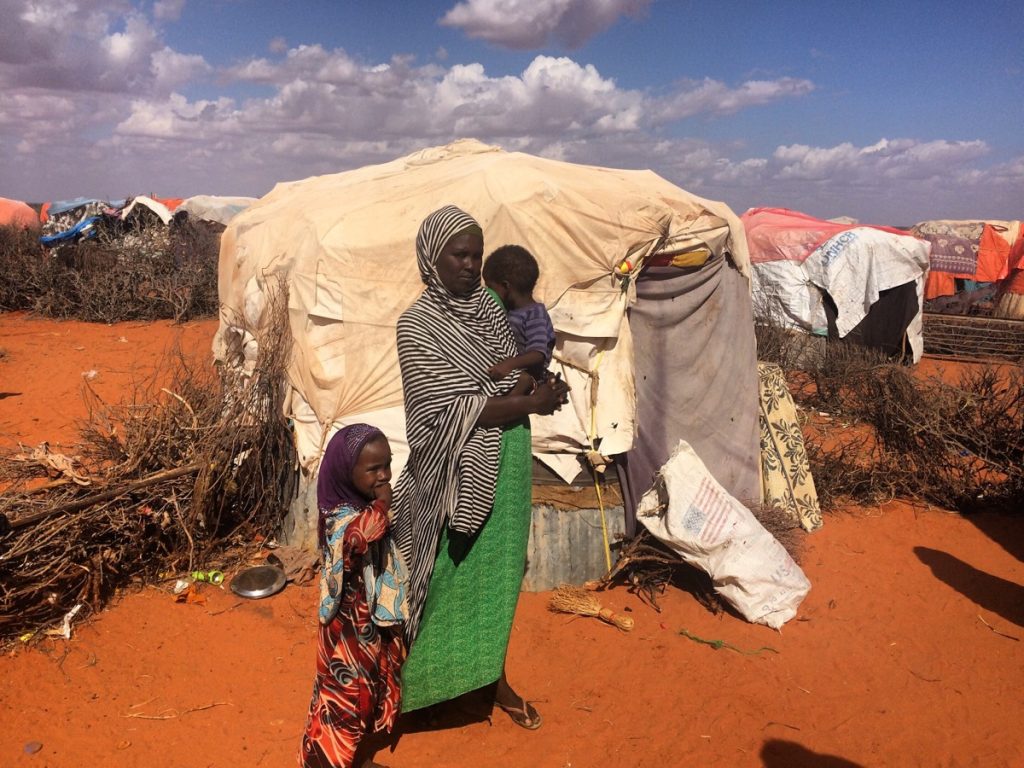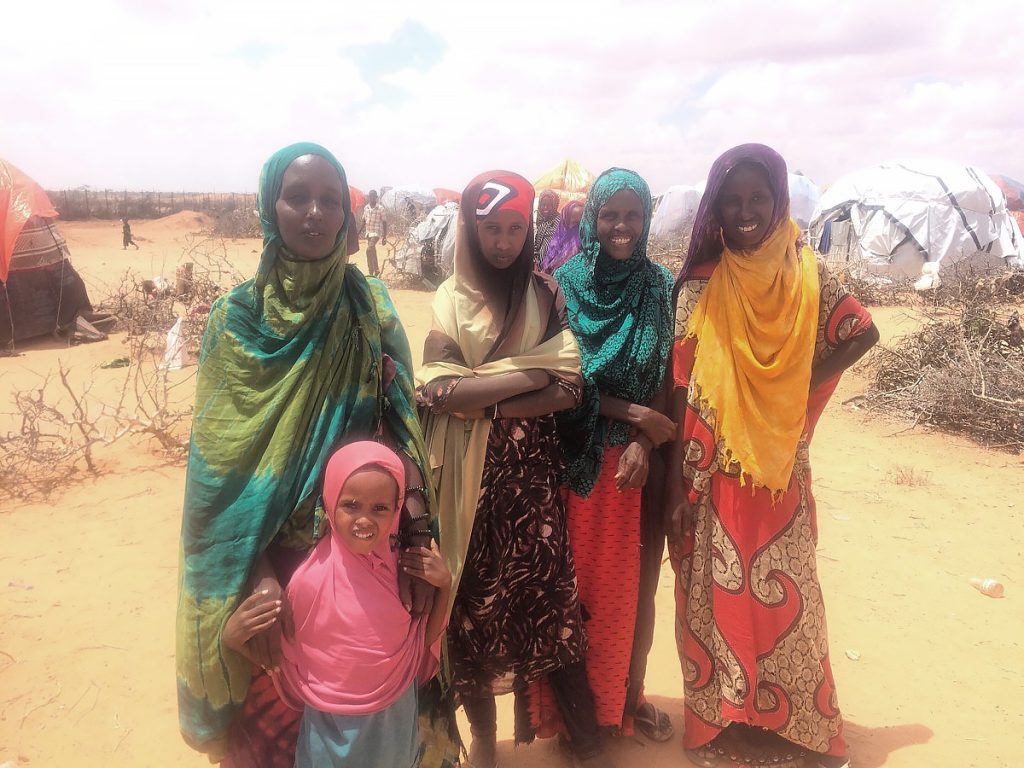Share
Somalia is facing a prolonged drought which has left 6.7 million people — more than half the population of the country – in need of humanitarian assistance. The situation continues to deteriorate and the possibility of famine in 2017 remains very real, despite an already massive scale-up of assistance.
We approached OCHA’s Humanitarian Data Exchange (HDX) team to develop a data visualization showing which organizations are distributing cash assistance across the country. The goal was to support partners in mapping their activities, and ultimately, strengthen coordination and enable faster decision-making. We also hoped to inform the general public about the ongoing response to the drought crisis.

A family displaced by the drought in Haar-Haar IDP settlement in Gaalkacyo, central Somalia. Women and children represent 84 per cent of the drought-displaced population since November 2016, according to UNHCR. Photo: Jordi Casafont Torra
Thanks to the data shared by partners, we are able to show who is doing what and where in cash-based assistance at the district level. The data and visualization will be updated on a monthly basis.
Why Cash?
The expansion of cash-based programming in Somalia is central to the strategy for famine prevention, and constitutes a predominant feature of the current response, building on work that began in 2011. Humanitarian access in Somalia is hampered by insecurity and the logistical challenges inherent to a vast territory. Cash-based assistance allows affected people to choose and buy their own food and non-food items from local shops across the country, helping to sustain the local economy in this critical time.
This modality of assistance is possible in Somalia because markets are functioning, despite the challenges associated with violence and inter-clan conflicts. Prices of local staples have increased since late 2016, but market-based responses continue to be feasible and appropriate across all monitored markets (see the Cash and Markets Dashboard for April 2017).
The Somalia Cash Working Group (CWG) is responsible for coordinating cash-based interventions, mapping the cash-based response, setting standards and guidelines for quality interventions and compiling analysis of market conditions across Somalia. The CWG is co-chaired by WFP and ADESO, with the support of the Cash Learning Partnership (CaLP), a global partnership of humanitarian actors engaged in policy, practice and research within cash transfer programming.
Highlights
In April, NGOs and UN agencies have continued to scale up cash-based assistance (cash and vouchers) with an estimated 2.4 million people reached and near $35 million disbursed directly to people affected by the drought, according to the data reported to OCHA Somalia (see the Cash Snapshot, as of April 2017)
Cash interventions can be ‘restricted’ or ‘unrestricted’, depending on whether there are any limitations given to how people use the transfer once received. For instance, vouchers are by default restricted transfers as the assistance can only be spent on the commodities designated on the voucher. Giving ‘cash in hand’ or through a mobile phone is unrestricted since people can spend the money as they wish. In April, 60 per cent of the people reached received ‘unrestricted’ cash transfers.
Cash transfers can be ‘conditional’ or ‘unconditional’. A conditional transfer requires beneficiaries to undertake a specific action or activity in order to receive assistance; the most common one in Somalia is ‘cash-for-work’. In April, 82 per cent of the cash-based assistance was ‘unconditional’, seeking to mitigate the alarming situation of millions of Somalis who have lost all their livelihoods as a result of the drought.
The NGOs Norwegian Refugee Council, Concern Worldwide, and Save the Children, which combined have reached near 500,000 people and disbursed some $6.6 million, have made the vast majority of their cash interventions unconditional and unrestricted.
Partners are using cash in a variety of ways, with most interventions addressing food security and water and sanitation concerns. Some are using cash to support girls’ education, assist people with special needs (e.g. the elderly, disabled, orphan children), help refugees returning from Kenya or Yemen (UNHCR), or to purchase non-food items such as blankets, jerry cans, or shelter materials for those displaced.
Food security partners use different mechanisms to transfer the money to the population. The most popular is WFP’s SCOPE card (an example of an “e-voucher”). It is a digital card that works with a point-of-sale device that beneficiaries use to purchase food in select retail locations, with top-ups being made in each distribution cycle. Fingerprints are stored on the cards and beneficiaries verify their identity at the time of purchase to ensure the intended person is the one using the card. In April, over 800,000 people were assisted this way.

Women-led households displaced by the drought in Haar-Haar IDP settlement in Gaalkacyo, central Somalia. Women and children represent 84 per cent of the drought-displaced population since November 2016, according to UNHCR. Photo: Jordi Casafont Torra
Mobile phone transfers are also being used on a large scale to deliver cash for the drought response. According to a 2016 World Bank report, 88 per cent of Somalis above the age of 16 own at least one SIM card, while 83 per cent of SIM card owners use mobile money. In April alone, over 670,000 people were reached through mobile transfers.
Another common mechanism is ‘cash in hand’, which is used by FAO in its work to support the restoration of livelihoods, with nearly 490,000 people reached in April. WASH partners use ‘vouchers’ that people redeem for water from vendors on a daily basis. UNICEF and IOM reached 275,000 and 158,000 people respectively in April.
How to Read Cash Data
The HDX visualization allows for the different sectors to be filtered independently. The map will then flag the districts in which cash-based interventions have been implemented for food security, education, protection or shelter.
The user may choose to filter information based on the circle graphs above, in order to understand for instance which organizations are using restricted/ unrestricted transfers or which ones are delivering the transfers through mobile phones.
Within a particular sector, the user may choose to visualize the interventions of a given partner, which will be highlighted in the district map and further explained in the cash components circle graphs.
Limitations
Mapping cash-based interventions in response to the current drought in Somalia started in March so the data should be treated with caution.
WASH vouchers have not yet been included in the visualization since some critical data components were missing. It has not been feasible either to visualize the different transfer values that partners are delivering in every region / district due to the lack of consistency in the data provided. Further, the analysis of rural/ urban interventions should be only considered as preliminary.
Finally, some cash-based interventions remain under-reported, which is being addressed by the collection of cash data being streamlined through the respective Clusters as of May.
We welcome your feedback and questions. Please share comments with us through hdx@un.org.

